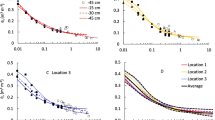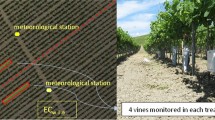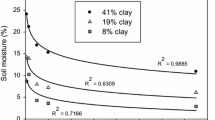Abstract
A common irrigation strategy is to replenish the soil water reservoir according to evapotranspiration (ET). However, the ET from plants under deficit irrigation is not well explored and is normally assumed to be a constant fraction of their respective well-watered condition. In the current experiment, we hypothesized that the ratio between the ET of well-watered (WW) and water deficit (WD) grapevines is not constant but depends on the reference ET (ETO). The hypothesis was tested using lysimeters over two consecutive seasons to measure the ET of WD grapevines (Vitis vinifera L.) that were irrigated at 35 % of a second set of lysimeters with WW vines. The WD treatment started at veraison and resulted in a quick depletion of the soil water reservoir; thereafter a relatively stable soil water content (θ) and crop coefficient (KC) were measured. The ET of the WD vines was 20–75 % lower than that of the WW vines, depending on the reference evapotranspiration (ETO). Under high ETO, the difference between the treatments was much larger than under low ETO. The dynamic ratio between the ET of the treatments demonstrates the difficulty in predicting the ET of WD plants and suggests that irrigation according to a constant fraction from a WW plant might result in either excessive or insufficient irrigation amounts. The high correlation between instantaneous stomatal conductance (g s) measurements and KC emphasizes the advantage of utilizing g s to improve current irrigation models.






Similar content being viewed by others
References
Allen RG, Pereira LS, Raes D, Smith M (1998) Crop evapotranspiration-Guidelines for computing crop water requirements-FAO Irrigation and drainage paper 56. FAO Rome 300:D05109
Annandale J, Stockle C (1994) Fluctuation of crop evapotranspiration coefficients with weather: a sensitivity analysis. Irrig Sci 15:1–7
Ben-Gal A, Kool D, Agam N, van Halsema GE, Yermiyahu U, Yafe A, Presnov E, Erel R, Majdop A, Zipori I (2010) Whole-tree water balance and indicators for short-term drought stress in non-bearing ‘Barnea’olives. Agric Water Manag 98:124–133
Cifre J, Bota J, Escalona JM, Medrano H, Flexas J (2005) Physiological tools for irrigation scheduling in grapevine (Vitis vinifera L.): an open gate to improve water-use efficiency? Agric Ecosyst Environ 106:159–170
Collins MJ, Fuentes S, Barlow EW (2010) Partial rootzone drying and deficit irrigation increase stomatal sensitivity to vapour pressure deficit in anisohydric grapevines. Funct Plant Biol 37:128–138
Evett SR, Schwartz RC, Howell TA, Baumhardt RL, Copeland KS (2012) Can weighing lysimeter ET represent surrounding field ET well enough to test flux station measurements of daily and sub-daily ET? Adv Water Resour 50:79–90
Feddes RA, Hoff H, Bruen M, Dawson T, de Rosnay P, Dirmeyer P, Jackson RB, Kabat P, Kleidon A, Lilly A, Pitman AJ (2001) Modeling root water uptake in hydrological and climate models. Bull Am Meteorol Soc 82:2797–2809
Fereres E, Soriano MA (2007) Deficit irrigation for reducing agricultural water use. J Exp Bot 58:147–159
Franks PJ (2013) Passive and active stomatal control: either or both? New Phytol 198:325–327
Green S, Clothier B, van den Dijssel C, Deurer M, Davidson P (2008) Measuring and modeling the stress response of grapevines to soil-water deficits. In: Ahuja LR et al (eds) Response of crops to limited water: understanding and modeling water stress effects on plant growth processes. ASA, CSSA, SSSA, Madison, WI, pp 357–385
Herrera JC, Bucchetti B, Sabbatini P, Comuzzo P, Zulini L, Vecchione A, Peterlunger E, Castellarin SD (2015) Effect of water deficit and severe shoot trimming on the composition of Vitis vinifera L. Merlot grapes and wines. Aust J Grape Wine Res 21:254–265
Hochberg U, Degu A, Fait A, Rachmilevitch S (2013) Near isohydric grapevine cultivar displays higher photosynthetic efficiency and photorespiration rates under drought stress as compared with near anisohydric grapevine cultivar. Physiol Plant 147:443–453
Intrigliolo DS, Castel JR (2010) Response of grapevine cv. ‘Tempranillo’to timing and amount of irrigation: water relations, vine growth, yield and berry and wine composition. Irrig Sci 28:113–125
López-Urrea R, Montoro A, Mañas F, López-Fuster P, Fereres E (2012) Evapotranspiration and crop coefficients from lysimeter measurements of mature ‘Tempranillo’wine grapes. Agric Water Manag 112:13–20
Mata M, Girona J, Goldhamer D, Fereres E, Cohen M, Johnson R (1999) Water relations of lysimeter-grown peach trees are sensitive to deficit irrigation. Calif Agric 53:17–20
Matthews M, Anderson MM, Schultz HR (1987) Phenologic and growth responses to early and late season water deficits in Cabernet franc. Vitis 26:147–160
Montero FJ, De Juan JA, Cuesta A, Brasa A (2000) Nondestructive methods to estimate leaf area in Vitis vinifera L. HortScience 35:696-698
Munitz S, Netzer Y, Schwartz A (2016) Sustained and regulated deficit irrigation of field-grown Merlot grapevines. Aust J Grape Wine Res. doi:10.1111/ajgw.12241
Netzer Y, Yao C, Shenker M, Bravdo BA, Schwartz A (2009) Water use and the development of seasonal crop coefficients for Superior Seedless grapevines trained to an open-gable trellis system. Irrig Sci 27:109–120
Oren R, Sperry JS, Katul GG, Pataki DE, Ewers BE, Phillips N, Schäfer KVR (1999) Survey and synthesis of intra-and interspecific variation in stomatal sensitivity to vapour pressure deficit. Plant Cell Environ 22:1515–1526
Picón-Toro J, González-Dugo V, Uriarte D, Mancha L, Testi L (2012) Effects of canopy size and water stress over the crop coefficient of a “Tempranillo” vineyard in south-western Spain. Irrig Sci 30:419–432
Pou A, Flexas J, Alsina MM, Bota J, Carambula C, De Herralde F, Galmés J, Lovisolo C, Jiménez M, Ribas-Carbó M (2008) Adjustments of water use efficiency by stomatal regulation during drought and recovery in the drought-adapted Vitis hybrid Richter-110 (V. berlandieri × V. rupestris). Physiol Plant 134:313–323
Raes D, Steduto P, Hsiao TC, Fereres E (2009) AquaCrop the FAO crop model to simulate yield response to water: II. Main algorithms and software description. Agron J 101:438–447
Rana G, Katerji N, Introna M, Hammami A (2004) Microclimate and plant water relationship of the “overhead” table grape vineyard managed with three different covering techniques. Sci Hort 102:105–120
Rapaport T, Hochberg U, Rachmilevitch S, Karnieli A (2014) The effect of differential growth rates across plants on spectral predictions of physiological parameters. PLoS One 9(2):e88930. doi:10.1371/journal.pone.0088930
Rogiers SY, Greer DH, Hutton RJ, Landsberg JJ (2009) Does night-time transpiration contribute to anisohydric behaviour in a Vitis vinifera cultivar? J Exp Bot 60:3751–3763
Romero P, Fernandez-Fernandez JI, Martinez-Cutillas A (2010) Physiological thresholds for efficient regulated deficit-irrigation management in winegrapes grown under semiarid conditions. Am J Enol Vitic 61:300–312
Schroeder JI, Allen GJ, Hugouvieux V, Kwak JM, Waner D (2001) Guard cell signal transduction. Ann Rev Plant Biol 52:627–658
Shellie KC (2006) Vine and berry response of Merlot (Vitis vinifera L.) to differential water stress. Am J Enol Vitic 57:514–518
Soar C, Speirs J, Maffei S, Penrose A, McCarthy M, Loveys B (2006) Grape vine varieties Shiraz and Grenache differ in their stomatal response to VPD: apparent links with ABA physiology and gene expression in leaf tissue. Aust J Grape Wine Res 12:2–12
Sperry JS, Love DM (2015) What plant hydraulics can tell us about responses to climate-change droughts. New Phytol 207:14–27
Steduto P, Raes D, Hsiao T, Fereres E, Heng L, Izzi G, Hoogeveen J (2009) AquaCrop: a new model for crop prediction under water deficit conditions. FAO, Rome
Tombesi S, Nardini A, Farinelli D, Palliotti A (2014) Relationships between stomatal behavior, xylem vulnerability to cavitation and leaf water relations in two cultivars of Vitis vinifera. Physiol Plantarum 152:453–464
Tramontini S, Döring J, Vitali M, Ferrandino A, Stoll M, Lovisolo C (2014) Soil water-holding capacity mediates hydraulic and hormonal signals of near-isohydric and near-anisohydric Vitis cultivars in potted grapevines. Funct Plant Biol 41:1119–1128
Tyree MT, Sperry JS (1989) Vulnerability of xylem to cavitation and embolism. Annu Rev Plant Biol 40:19–36
Van den Honert T (1948) Water transport in plants as a catenary process. Discuss Faraday Soc 3:146–153
Williams L, Ayars J (2005) Grapevine water use and the crop coefficient are linear functions of the shaded area measured beneath the canopy. Agric For Meteorol 132:201–211
Williams L, Phene C, Grimes D, Trout T (2003) Water use of mature Thompson Seedless grapevines in California. Irrig Sci 22:11–18
Williams L, Baeza P, Vaughn P (2012) Midday measurements of leaf water potential and stomatal conductance are highly correlated with daily water use of Thompson Seedless grapevines. Irrig Sci 30:201–212
Acknowledgments
The work was part of the IRRIGATE (Intelligent Irrigation for Grape Quality) project in collaboration with NETAFIM L.T.D. The project was funded by the Chief Scientist of the Israeli Ministry of Economy and the Italian Ministry of Foreign Affairs. We thank Mr. Diego Chiabà for his support in lysimeters set-up and Mr. Moreno Greatti for his assistance in vineyard management.
Author information
Authors and Affiliations
Corresponding author
Additional information
Communicated by E. Fereres.
Rights and permissions
About this article
Cite this article
Hochberg, U., Herrera, J.C., Degu, A. et al. Evaporative demand determines the relative transpirational sensitivity of deficit-irrigated grapevines. Irrig Sci 35, 1–9 (2017). https://doi.org/10.1007/s00271-016-0518-4
Received:
Accepted:
Published:
Issue Date:
DOI: https://doi.org/10.1007/s00271-016-0518-4




